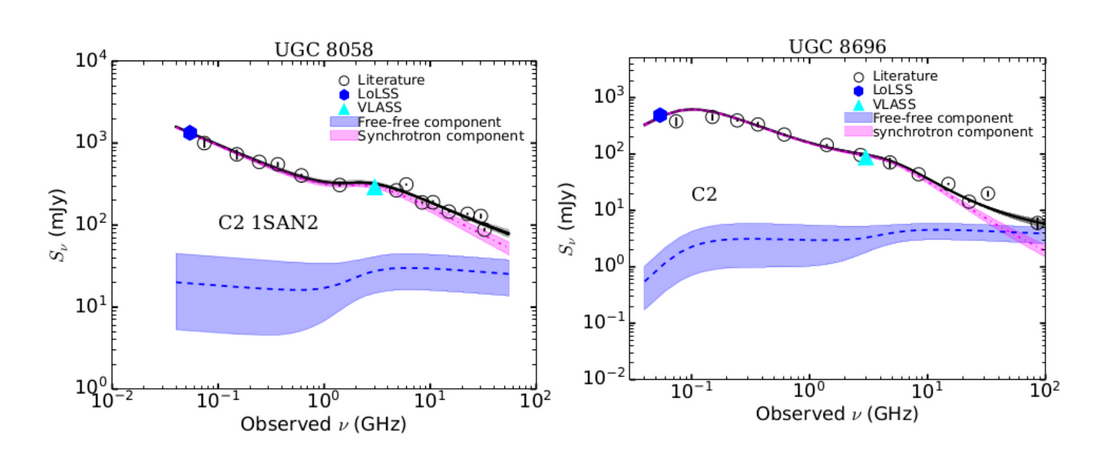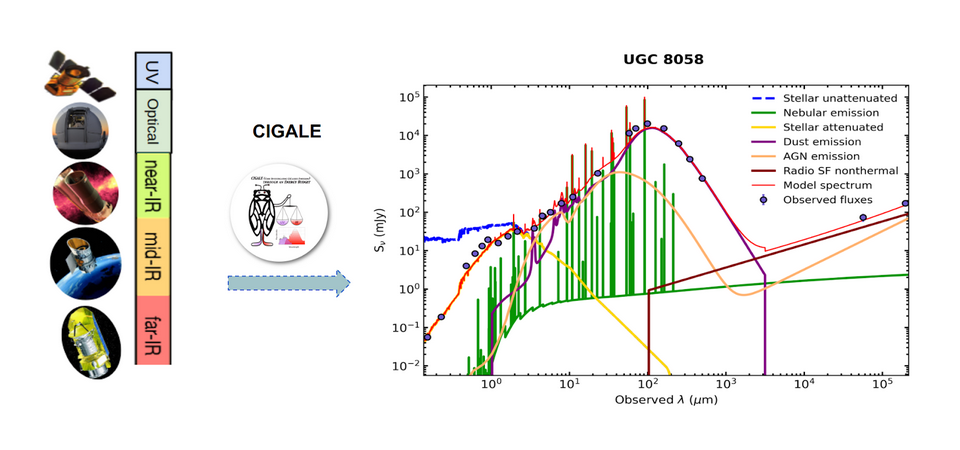Astronomy Object of the Month: July 2024
< previous Archive next >
Panchromatic SED modeling of infrared bright galaxies
The field of galaxy formation and evolution has undergone a revolutionary transformation over the past two decades, facilitated by abundant data collected from multiwavelength photometric and spectroscopic surveys. These observations play a crucial role in understanding the star formation history of the Universe, determining the redshift of the first proto-galaxies, and tracing the evolutionary processes of small components into the massive galaxies observed today.

Illustration: Radio-only SED for galaxy UGC 8058 and UGC 8696. The solid black line represents the best-fit model, while the gray shaded region represents the 1σ uncertainties sampled by the UltraNest package. The dotted–dashed magenta and dotted blue lines show the decomposed synchrotron and free–free components. The pink and blue shaded regions represent the 1σ uncertainties in the synchrotron and free–free components, respectively. Credit: The Authors.
These evolutionary processes leave an imprint on the global and detailed shape of the galaxy spectrum, each dominating at different wavelengths. The emission from galaxies in γ-rays to radio wavelength is the outcome of the complex physical interplay between their main baryonic components: stars of all ages and their remnants; molecular, atomic, and ionized gas; dust and supermassive black holes. A comprehensive approach to panchromatic spectral energy distribution (in short: SED), hence modeling, is an essential tool to advance our understanding of galaxy evolution.
We have focused on bridging the gap between ultraviolet (UV) – infrared (IR) and radio-only SED modeling for galaxies, which traditionally have been pursued independently. By simultaneously incorporating these two regimes, we captured the interconnectedness of the underlying physical processes and gained a more holistic understanding of galaxy evolution.
In our study, SED modeling is performed for infrared bright galaxies, namely, Luminous and Ultra-luminous Infrared Galaxies (U/LIRGs). The bulk infrared emission in these galaxies is due to warm dust heated by active galactic nuclei (AGN), starbursts due to major mergers, or both. This correlates well with the widely accepted evolutionary picture, which places U/LIRGs at a fixed stage in the evolutionary sequence between the transformation of gas-rich galaxies and red-dead elliptical ones. Therefore, they provide excellent nearby laboratories for studying in detail the physical processes associated with the hierarchical transformation of star-forming galaxies into elliptical galaxies.
We performed detailed SED modeling of 14 local ULIRGs with outstanding photometric data from the literature covering the UV-FIR and radio bands (∼50 MHz to ∼30 GHz). Combining the results from our previous study on 11 LIRGs (Dey et al. 2022), we discuss the global astrophysical properties of a sample of 25 starburst galaxies with z < 0.5.
For radio-only SED modeling, we construct a series of comprehensive radio continuum SEDs, ranging from 54 MHz to 30 GHz in the observed frame. Our aim is to isolate the thermal free-free component and identify the effects of free-free absorption (FFA) at low frequencies. The free-free emission directly traces star formation rate (SFR), making it an excellent candidate for crafting SFR measures that are compatible with high-redshift SFGs, which will be revealed with the Square Kilometre Array (SKA) and its pathfinder projects.
Our analysis of densely sampled radio-only SEDs from LIRGs and ULIRGs revealed that single power-law forms rarely describe their spectra. Instead, numerous bends and turnovers were observed (see Figure 1.). These turnovers are attributed to multiple star-forming regions with different compositions or geometric orientations integrated over by a large synthesized beam, such is the case of an unresolved galaxy, the observed radio continuum could be complex. Some ULIRGs were identified as radio-loud AGNs due to the presence of Gigahertz-Peaked Spectrum (GPS) AGNs in their centers. However, the bends in the radio SEDs were attributed to free-free absorption rather than synchrotron self-absorption or Tsytovitch-Razin effects. Similarly, at higher frequencies, kinks or steepenings were often observed, indicating a secondary component of free-free absorption with high emission measures.
For UV-IR-radio SED modeling, we used publicly available data in 20-30 bands from various open-sourced space-based observing facilities. We employed the Code Investigating GALaxy Emission (CIGALE) SED fitting tool for the modeling (Figure 2). CIGALE has been extensively used to model star-forming galaxies, LIRGs, and ULIRGs, but only a limited number of studies have incorporated radio measurements into the SED fitting process. Including radio measurements in CIGALE modeling primarily enhances the constraints on dust luminosity and star formation rate (SFR). Our study highlights the importance of integrating radio data into the UV-IR SED modeling for a better characterization of the astrophysical properties of galaxies.
Further, SED modeling with CIGALE allowed us to obtain SFRIR averaged over different time intervals (i.e., 10 and 100 Myr), enabling us to validate the SFR calibration as a function of star formation history. Our radio-only SED modeling enabled us to decompose the total radio emission into thermal and nonthermal components. Using the SFR calibration relation presented in Murphy et al. (2011), we calculated the total, nonthermal, and thermal SFRs at 1.4 GHz and compared them with SFRIR obtained from SED modeling using CIGALE averaged over 10 and 100 Myr. We demonstrated that the total and nonthermal radio luminosity at 1.4 GHz are reliable estimators of recent SFRs for all LIRGs and ULIRGs that do not exhibit significant radio loudness from AGNs. A weaker but still significant correlation was observed between radio SFR at 1.4 GHz and old (100 Myr) SFR based on SED modeling, indicating multiple episodes of starburst activity during their lifetimes. Furthermore, we showed that the total, nonthermal, and thermal radio luminosities at 4.8 GHz are also good tracers of recent SFRs for our sources. As expected, the thermal luminosity at 4.8 GHz proved to be a better tracer of recent SFR compared to the thermal luminosity at 1.4 GHz, suggesting that the free-free emission is optically thick at 1.4 GHz while becoming optically thin at 4.8 GHz.

Illustration 2: Best-fit UV-radio SED of galaxy UGC 8058 (in red) along with the emission from AGN (in orange), dust (in yellow), nebular (in green), and stellar (in blue) components. Credit: The Authors.
Original publication: Subhrata Dey, Arti Goyal, Katarzyna Małek, Tanio Díaz-Santos, Insights into the Global Properties of Infrared Bright Galaxies, The Astrophysical Journal 966, 161, 31 (2024).
The findings described are part of a study conducted in the Department of High Energy Astrophysics of the Jagiellonian University Astronomical Observatory in Kraków.
|
Subhrata Dey Astronomical Observatory Jagiellonian University Subhrata.Dey [@] doctoral.uj.edu.pl |


